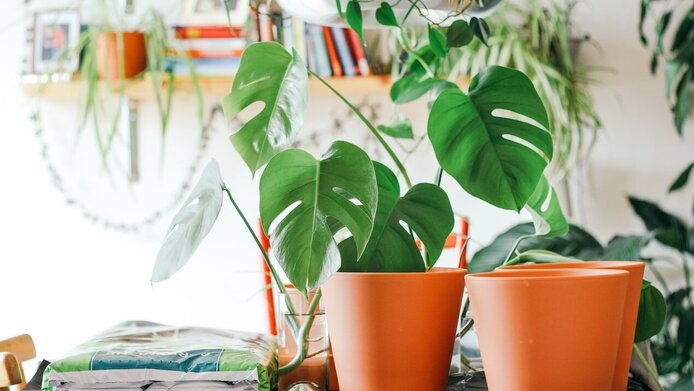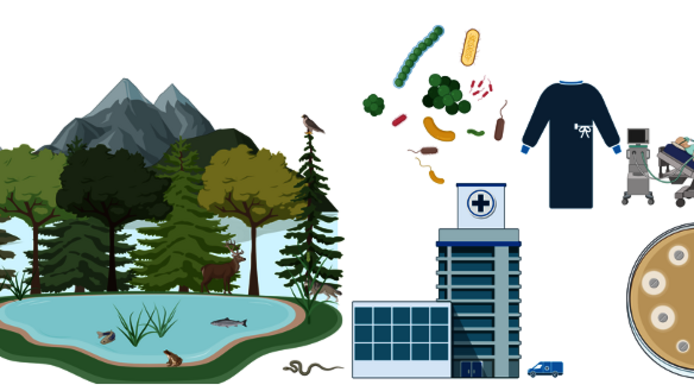Houseplants – welcome “super-spreaders”

The importance of rainforests as the lungs and pharmacy of the planet, a walk in the forest as an effective measure to unwind and relax, the constant supply of oxygen, food, heating sources and materials – the list of benefits that the world of plants has in store for us humans goes on and on. A new item is currently being added to that list by the BioTechMed-Graz research alliance. In a series of studies, Gabriele Berg, an environmental biotechnologist from the Graz University of Technology, teaming up with postdocs Wisnu Wicaksono and Alexander Mahnert, has investigated the effects of houseplants on indoor environments. Berg is investigating the plants’ microbiome, i.e. the diverse community of microorganisms that live on and in living organisms. A deeper understanding of the relationships between microbes, their “hosts”, and their surroundings could also result in new approaches for combating multi-resistant germs.
First stocktaking in the greenhouse
For the research project “Plant-associated microbial communities in indoor environments”, which was funded by the Austrian Science Fund FWF, the team started by describing and taking stock of the microbiomes on indoor plants. To do this, they took samples at the Botanical Garden in Graz, where around 15 common houseplants such as spider plant, banana tree and Dracaena are growing under controlled conditions: “Houseplants have a very vibrant microbiome. Each species hosts its own microorganisms and they do it independently of environmental factors. We have found around one million bacteria and 1,000 fungi per square centimetre of leaf surface. They have an effect on plant health, on a healthy microbial indoor climate, and protect the plant itself from diseases,” Gabriele Berg explains. In a next step, the researchers “locked up” individual plants in sterile cabinets to observe how the microbiome influences surrounding surfaces, and they found out that unobtrusive and low-maintenance houseplants are “positive microbial super-spreaders”.
Nurturing the microbiome in the right way
Some indoor spaces, for instance intensive care units, are expected to be as germ-free as possible. However, multi-resistant germs, which have upgraded their antibiotic resistance arsenals among themselves, regularly kill people in these very environments: “Comparisons between interiors that are left in a near-natural state and those that undergo different cleaning routines have told us that our current microbiome management is going in the wrong direction,” Gabriele Berg explains. The targeted cultivation of a microbial community could be a viable approach to making the air in sensitive indoor environments healthier.
How and why do microbial communities deteriorate from a diverse, beneficial and useful range to a harmful structure that is resistant to antibiotics? In order to answers this question, the Graz research group sampled a variety of indoor spaces ranging from “high exposure to plants” to “as sterile as possible”. “The methods we used were developed by NASA in order not to transmit germs from Earth to other planets with the vehicles used for space missions. Nothing is as spick and span as a Mars Rover,” says Berg, talking about the tools and methods used by the team.
Assembling villains from fragments
Accordingly, the team looked like spacemen and spacewomen in their protective gear when they sampled farmhouses, clean rooms and intensive care units. While there is little DNA on sterile surfaces as found in hospitals, they nevertheless contain a wealth of information. After sequencing the complete “metagenome” of samples taken from intensive care units, Berg's group compared the sequences with databases and, using new bioinformatics algorithms, reassembled entire microorganism species from the piecemeal DNA. Thomas Rattei, a bioinformatics specialist from the University of Vienna, assisted with the data management. The finds included the dreaded Acinetobacter baumannii, which was able to exchange resistance genes with other germs in a hospital setting.
The results of this pioneering study on near-natural conditions, diversity and the accumulation of antibiotic resistance in indoor spaces were published in the Nature Communications journal in 2019. Gabriele Berg summarises the findings as follows: “Wherever high bacterial diversity prevails, there are few multi-resistance genes.” Where there are many microorganisms they keep each other in check, one might say, or in other words: the higher the level of cleaning in a room, the more one-sided its microbial community becomes and resistances can accumulate.
On the way to a health-promoting microbiome
Unhealthy clinical microbiomes result from the interaction of a large number of sick people, a careless use of antibiotics and tried-and-tested cleaning regimes. The good news is “that we can now evaluate what we are doing”, as Gabriele Berg underlines. With the help of the beneficial plant microbiomes sampled from the greenhouse, the team wants to get closer to solving the problem in follow-up studies: “In the laboratory, we want to reproduce the effect of different cleaning regimes and agents in a targeted manner, using a model community from the greenhouse.” In this way, the researcher intends to model and develop improved processes and the appropriate use of cleaning agents.
Personal details
Gabriele Berg studied biology, ecology and biotechnology at the universities of Rostock and Greifswald. In 2005 she was appointed to the chair of Environmental Biotechnology at Graz University of Technology. Her research focuses on microbiomes on hosts and the translation of results into new biotechnological concepts for the environment and “holobiont health”, i.e. the beneficial interaction of microorganisms with higher plants and animals. The project “Plant-associated microbial communities in indoor environments” (2016-2020) received EUR 350,000 in funding from the Austrian Science Fund FWF.
Publications
Mahnert, A., Moissl-Eichinger, C., Zojer, M. et al.: Man-made microbial resistances in built environments, in: Nature Communications 10, 968, 2019
Mahnert, A., Haratani, M., Schmuck, M., & Berg, G.: Enriching beneficial microbial diversity of indoor plants and their surrounding built environment with biostimulants, in: Frontiers in Microbiology, 9, 2985, Dec. 2018
Mahnert, A., Ortega, R. A., Berg, C., Grube, M., & Berg, G.: Leaves of indoor ornamentals are biodiversity and functional hotspots for fungi, in: Frontiers in Microbiology, 9, 2343, Oct. 2018






